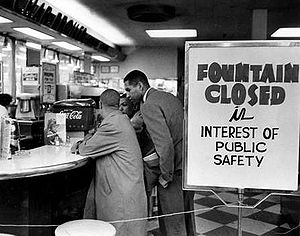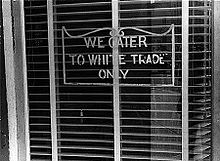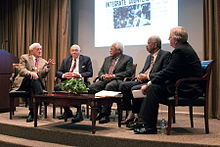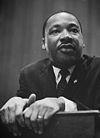- Nashville sit-ins
-
 Nashville's sit-in campaign targeted downtown lunch counters such as this one at Walgreens drugstore.
Nashville's sit-in campaign targeted downtown lunch counters such as this one at Walgreens drugstore.
The Nashville sit-ins, which lasted from February 13 to May 10, 1960, were part of a nonviolent direct action campaign to end racial segregation at lunch counters in downtown Nashville, Tennessee. The sit-in campaign, coordinated by the Nashville Student Movement and Nashville Christian Leadership Council, was notable for its early success and emphasis on disciplined nonviolence.
Over the course of the campaign, sit-ins were staged at numerous stores in Nashville's central business district. Sit-in participants, who consisted mainly of black college students, were often verbally or physically attacked by white onlookers. Despite their refusal to retaliate, over 150 students were eventually arrested for refusing to vacate store lunch counters when ordered to do so by police. At trial, the students were represented by a group of 13 lawyers, headed by Z. Alexander Looby. On April 19, Looby's home was bombed, however, neither he nor his wife were injured. Later that day, nearly 4000 people marched to City Hall to confront Mayor Ben West about the escalating violence. When asked if he believed the lunch counters in Nashville should be desegregated, West agreed that they should. After subsequent negotiations between the store owners and protest leaders, an agreement was reached during the first week of May. On May 10, six downtown stores began serving black customers at their lunch counters for the first time.
Although the initial campaign successfully desegregated downtown lunch counters, sit-ins, pickets, and protests against other segregated facilities continued in Nashville until passage of the Civil Rights Act of 1964 which ended overt, legally sanctioned segregation nationwide. Many of the organizers of the Nashville sit-ins went on to become important leaders in the U.S. Civil Rights Movement.
Contents
Historical context
Main article: Racial segregation in the United States A sign on a restaurant window in Lancaster, Ohio, in 1938
A sign on a restaurant window in Lancaster, Ohio, in 1938
In 1896, the United States Supreme Court decision Plessy v. Ferguson upheld the constitutionality of racial segregation under the doctrine of "separate but equal". This decision led to the proliferation of Jim Crow laws throughout the United States. These laws mandated segregation in virtually all spheres of public life and allowed racial discrimination to flourish across the country, especially in the Southern United States.[1][2]
In Nashville, like most Southern cities, African Americans were severely disadvantaged under the system of Jim Crow segregation. Besides being relegated to underfunded schools[3] and barred from numerous public accommodations, African Americans had few prospects for skilled employment and were subject to constant discrimination from the white majority.[4]
Although serious efforts were made to oppose Jim Crow laws in Nashville as early as 1905,[note 1] it was not until 1958, with the formation of the Nashville Christian Leadership Council, that Nashville's African American community would lay the foundation for dismantling racial segregation.[5]
Precursors and organization
The Nashville Christian Leadership Council (or NCLC), was founded by the Reverend Kelly Miller Smith, pastor of First Baptist Church, Capitol Hill. This organization was an affiliate of Martin Luther King, Jr.'s Southern Christian Leadership Conference and was established to promote civil rights for African Americans through nonviolent civil disobedience. Smith believed that Americans would be more sympathetic to desegregation if African Americans obtained their rights through peaceful demonstration rather than through the judicial system.[6]
From March 26 to March 28, 1958, the NCLC held the first of many workshops on using nonviolent tactics to challenge segregation.[5][7] These workshops were led by James Lawson, who had studied the principles of nonviolent resistance while working as a missionary in India. The workshops were mainly attended by students from Fisk University, Tennessee A&I (later Tennessee State University), American Baptist Theological Seminary (later American Baptist College), and Meharry Medical College. Among those attending Lawson's sessions were students who would become significant leaders in the Civil Rights Movement, among them: Marion Barry, James Bevel, Bernard Lafayette, John Lewis, Diane Nash, and C. T. Vivian.[8]
During these workshops it was decided that the first target for the group's actions would be downtown lunch counters. At the time, African Americans were allowed to shop in downtown stores but were not allowed to eat in the stores' restaurants. The group felt that the lunch counters were a good objective because they were highly visible, easily accessible, and provided a stark example of the injustices black Southerners faced every day.[9]
In late 1959, James Lawson and other members of the NCLC's projects committee met with department store owners Fred Harvey and John Sloan, and asked them to voluntarily serve African Americans at their lunch counters. Both men declined, saying that they would lose more business than they would gain. The students then began doing reconnaissance for sit-in demonstrations. The first test took place at Harveys Department Store in downtown Nashville on November 28, followed by the Cain-Sloan store on December 5.[10][11] Small groups of students purchased items at the stores and then sat at their lunch counters and attempted to order food. Their goal was to try to sense the mood and degree of resistance in each store. Although they were refused service at both lunch counters, the reactions varied significantly. At Harveys, they received surprisingly polite responses, while at Cain-Sloan they were treated with contempt.[12][13] These reconnaissance actions were low-key and neither of the city's newspapers was notified of them.[14]
Full-scale demonstrations
Before the students in Nashville had a chance to formalize their plans, events elsewhere brought renewed urgency to the effort. During the first week of February 1960, a small sit-in demonstration in Greensboro, North Carolina grew into a significant protest with over eighty students participating by the third day. Although similar demonstrations had occurred previously in other cities, this was the first to attract substantial media attention and public notice.[15] When Lawson's group met the subsequent Friday night, about 500 new volunteers showed up to join the cause. Although Lawson and other adult organizers argued for delay, the student leaders insisted that the time had come for action.[16]
 Downtown lunch counters targeted by the sit-ins included: 1. S. H. Kress; 2. McLellans; 3. Woolworths; 4. Harveys; 5. Walgreens; 6. Grants; 7. Cain-Sloan; 8. Greyhound; 9. Trailways; 10. Moon-McGrath
Downtown lunch counters targeted by the sit-ins included: 1. S. H. Kress; 2. McLellans; 3. Woolworths; 4. Harveys; 5. Walgreens; 6. Grants; 7. Cain-Sloan; 8. Greyhound; 9. Trailways; 10. Moon-McGrath
The first large-scale organized sit-in was on Saturday, February 13, 1960. At about 12:30 pm, 124 students, most of them black, walked into the downtown Woolworths, S. H. Kress, and McClellan stores and asked to be served at the lunch counters. After the staff refused to serve them, they sat in the stores for two hours and then left without incident.[17][18]
On the Monday following the first sit-in, the Baptist Minister's Conference of Nashville, representing 79 congregations, unanimously voted to support the student movement, thus throwing the weight of Nashville's black religious community behind the students.[19] Local religious leaders called on people of good will to boycott downtown merchants who practiced segregation. Nashville's black community strongly supported the boycott, causing economic hardship for the merchants.[20]
The second sit-in occurred on Thursday, February 18, when more than 200 students entered Woolworths, S. H. Kress, McClellan, and Grants. The lunch counters were immediately closed. The students remained for about half an hour and then left, again without incident.[21][22] The third sit-in occurred on February 20 when about 350 students entered the previous four stores and the downtown Walgreens drugstore. As the students sat at the counters, crowds of white youths gathered in several of the stores. Police kept a watchful eye on all five locations, but no incidents of violence occurred. The students remained for nearly three hours until adjourning to a mass meeting at the First Baptist Church.[23][24]
Tensions mounted over the following week as sit-in demonstrations spread to other cities and race riots broke out in nearby Chattanooga.[25][26] On February 27, the Nashville student activists held a fourth sit-in at the Woolworths, McClellan, and Walgreens stores. Crowds of white youths again gathered in the stores to taunt and harass the demonstrators. This time, however, police were not present. Eventually, several of the sit-in demonstrators were attacked by hecklers in the McClellan and Woolworths stores. Some were pulled from their seats and beaten, and one demonstrator was pushed down a flight of stairs. When police arrived, the white attackers fled and none were arrested.[27] Police then ordered the demonstrators at all three locations to leave the stores. When the demonstrators refused to leave, they were arrested and loaded into police vehicles as onlookers applauded. Eighty-one[note 2] students were arrested and charged with loitering and disorderly conduct.[28][29]
The arrests brought a surge of media coverage to the sit-in campaign, including national television news coverage,[30] front page stories in both of Nashville's daily newspapers,[28][31] and an Associated Press story.[32] The students generally viewed any media coverage as helpful to their cause, especially when it illustrated their commitment to nonviolence.[33]
Several other sit-ins took place over the following two months, resulting in more arrests and further attacks against sit-in participants. Over 150 students were arrested.[34] Throughout the demonstrations, the student activists maintained a policy of disciplined nonviolence. Their written code of conduct became a model followed by demonstrators in other cities:[34]
"Do not strike back or curse if abused. Do not laugh out. Do not hold conversations with the floor walker. Do not leave your seat until your leader has given you permission to do so. Do not block entrances to stores outside nor the aisles inside. Do show yourself courteous and friendly at all times. Do sit straight; always face the counter. Do report all serious incidents to your leader. Do refer information seekers to your leader in a polite manner. Remember the teachings of Jesus, Gandhi, Martin Luther King. Love and nonviolence is the way."[35]
Trials and Lawson expulsion
The trials of the sit-in participants attracted widespread interest throughout Nashville and the surrounding region. On February 29, the first day of the trials, a crowd of more than 2000 people lined the streets surrounding the city courthouse to show their support for the defendants.[36][37] A group of 13 lawyers, headed by Z. Alexander Looby, represented the students.[note 3] Initially, the trial was presided over by City Judge Andrew J. Doyle. Doyle dismissed the loitering charges against the students and then stepped down from the bench, turning the trial over to Special City Judge John I. Harris.[36]
Despite strong support from the black community, all the students who had been arrested were convicted of disorderly conduct and fined $50. The students refused to pay the fines, however, and chose instead to serve thirty-three days in the county workhouse.[37] Diane Nash issued a statement on behalf of the students explaining the decision: "We feel that if we pay these fines we would be contributing to and supporting the injustice and immoral practices that have been performed in the arrest and conviction of the defendants."[38]
The same day the trials began, a group of black ministers, including James Lawson, met with Mayor Ben West to discuss the sit-ins. Coverage of the meeting by the local press, including a scathing editorial in the Nashville Banner denouncing Lawson as a "flannel-mouth agitator",[39] brought Lawson's activities to the attention of Vanderbilt University where he was enrolled as a Divinity School student. When Lawson was confronted by Vanderbilt's executive committee and told he would have to end his involvement with the sit-ins, Lawson refused. He was immediately expelled from the university.[40][41]
Biracial Committee
 Diane Nash and Kelly Miller Smith review a prepared statement in response to the Biracial Committee's recommendation to partially integrate store lunch counters.
Diane Nash and Kelly Miller Smith review a prepared statement in response to the Biracial Committee's recommendation to partially integrate store lunch counters.
On March 3, to defuse the racial tensions caused by the sit-ins, Mayor West announced the formation of a Biracial Committee to seek a solution to the city's racial strife. The committee included the presidents of two of the city's black universities, but did not include any representatives from the student movement.[42][43] The committee met several times over the next month and delivered its recommendations in a report on April 5. The committee recommended to partially integrate the city's lunch counters. Each store would have one section that was for whites only and another section for whites and blacks. This solution was rejected by the student leaders, who considered the recommendations to be morally unacceptable and based upon a policy of segregation.[43][44] Less than a week after the Biracial Committee issued its report, the sit-ins resumed and the boycott of downtown businesses was intensified.[45][46]
Looby residence bombing
At 5:30 am on April 19, dynamite was thrown through a front window of Z. Alexander Looby's home in north Nashville,[47] apparently in retaliation for his support of the demonstrators. Although the explosion almost destroyed the house, Looby and his wife, who were asleep in a back bedroom, were not injured. More than 140 windows in a nearby dormitory were broken by the blast.[48]
Rather than discouraging the protesters, this event served as a catalyst for the movement. Within hours, news of the bombing had spread throughout the community. Around noon, nearly 4000 people marched silently to City Hall to confront the mayor.[49][50] Mayor West met the marchers at the courthouse steps. Reverend C. T. Vivian read a prepared statement accusing the mayor of ignoring the moral issues involved in segregation and turning a blind eye to violence and injustice. Diane Nash then asked the mayor if he felt it was wrong to discriminate against a person based solely on their race or skin color. West answered that he agreed it was wrong. Nash then asked him if he believed that lunch counters in the city should be desegregated. West answered, "Yes", then added, "That's up to the store managers, of course."[51][52]
Coverage of this event varied significantly between Nashville's two major newspapers. The Tennessean emphasized the mayor's agreement that lunch counters should be desegregated,[52] while the Nashville Banner emphasized the mayor's statement that it was up to the city's merchants to decide whether to desegregate.[53][54] This was largely indicative of the two papers' opposing stances on the issue.[55][56]
The next day Martin Luther King, Jr. came to Nashville to speak at Fisk University. During the speech, he praised the Nashville sit-in movement as "the best organized and the most disciplined in the Southland." He further stated that he came to Nashville "not to bring inspiration but to gain inspiration from the great movement that has taken place in this community."[57]
Desegregation
After weeks of secret negotiations between merchants and protest leaders, an agreement was finally reached during the first week of May. According to the agreement, small, selected groups of African Americans would order food at the downtown lunch counters on a day known in advance to the merchants. The merchants would prepare their employees for the event and instruct them to serve the customers without trouble. This arrangement would continue in a controlled manner for a couple of weeks and then all controls would be taken off, at which point the merchants and protest leaders would reconvene to evaluate the results. Also as part of the agreement, the media was to be informed of the settlement and requested to provide only accurate, non-sensational coverage.[58]
On May 10, six downtown stores opened their lunch counters to black customers for the first time. The customers arrived in groups of two or three during the afternoon and were served without incident. At the same time, African Americans ended their six-week-old boycott of the downtown stores.[59][60] The plan continued successfully and the lunch counters were integrated without any further incidents of violence. Nashville thus became the first major city in the South to begin desegregating its public facilities.[61][62]
Although the end of the sit-in campaign brought a brief respite for civil rights activists in Nashville, institutionalized racism remained a problem throughout the city. Over the next few years, further sit-ins, pickets, and other actions would take place at restaurants, movie theaters, public swimming pools, and other segregated facilities across Nashville.[62][63][64] These actions continued until Congress passed the Civil Rights Act of 1964, which prohibited segregation in public places throughout the United States.[1]
Fiftieth anniversary
 A panel including John Seigenthaler (left) and James Lawson (center) discuss media coverage of the Nashville sit-ins.
A panel including John Seigenthaler (left) and James Lawson (center) discuss media coverage of the Nashville sit-ins.
Several events were held during 2010 to mark the fiftieth anniversary of the Nashville sit-ins. On January 20, Vanderbilt University hosted a panel discussion entitled "Veterans of the Nashville Sit-ins - The Struggle Continues".[65] The featured speakers were Kwame Leo Lillard and Matthew Walker, Jr.[66] Tennessee State Museum hosted an exhibition from February 4 to May 16 entitled "We Shall Not Be Moved: The 50th Anniversary of Tennessee's Civil Rights Sit-Ins".[67] At Tennessee State University on February 10, the 29th annual Conference on African American History and Culture held a special commemoration of the sit-ins, with Diane Nash as the featured guest speaker.[68] On February 12, Vanderbilt University hosted a panel discussion on media coverage of the Nashville sit-ins. The featured speakers were James Lawson and John Seigenthaler.[69] The downtown Nashville library hosted a photography exhibit entitled "Visions & Voices: The Civil Rights Movement in Nashville & Tennessee" from February 9 to May 22. In addition, National Public Radio's Juan Williams lead a forum to discuss civil rights issues at the downtown library auditorium on February 13.[70]
Notes
- ^ Richard Henry Boyd, James Napier, Preston Taylor, and others organized a strike against Nashville's segregated streetcar service that lasted from July 1905 until July 1906. More information about this strike can be found in Bobby Lovett's A Black Man's Dream.
- ^ There are several conflicting sources on the number of students arrested on February 27: The initial story in The Tennessean claims 75 were arrested; a story in the Nashville Globe and Independent states that 79 were arrested; most later sources, such as Halberstam's The Children and Wynn's "The Dawning of a New Day", state that 81 students were arrested.
- ^ According to Fisk News and Nashville Globe and Independent, the lawyers representing the students were: Z. Alexander Looby; Robert Lillard; Avon Williams; Coyness L. Ennix; A. J. Steel; J. F. McClellan; R. B. J. Campbell, Jr.; Adolph Birch; W. D. Hawkins, Jr.; Roscoe Hamby; William Blakemore; E. B. Lindsey; and Eugene White.
References
- ^ a b Wynn, "The Dawning of a New Day", 42.
- ^ Klarman, From Jim Crow to Civil Rights, 3–289.
- ^ Lovett, A Black Man's Dream, 160.
- ^ Wynn, "The Dawning of a New Day", 43–44.
- ^ a b Wynn, "The Dawning of a New Day", 44.
- ^ Lovett, Profiles, 112.
- ^ Lovett, Profiles, 96.
- ^ Halberstam, The Children, 56, 95.
- ^ Halberstam, The Children, 90–91.
- ^ Glisson, The Human Tradition in the Civil Rights Movement, 164–166.
- ^ Wynn, "The Dawning of a New Day", 45.
- ^ Halberstam, The Children, 92.
- ^ Lewis, Walking with the Wind, 86–89.
- ^ Halberstam, The Children, 91.
- ^ Branch, Parting the Waters, 271–272.
- ^ Branch, Parting the Waters, 274.
- ^ Talley, James (February 14, 1960). "Strikes hit city". The Tennessean.
- ^ Sumner, Local Press, 67.
- ^ [Staff] (February 19, 1960). "Local Ministers To Support Student Movement". Nashville Globe and Independent.
- ^ Halberstam, The Children, 177–179.
- ^ Sumner, Local Press, 70.
- ^ [Staff] (February 19, 1960). "Negroes 'Strike' Counters Again". The Tennessean.
- ^ Sumner, Local Press, 71.
- ^ [Staff] (February 21, 1960). "Lunch Counter 'Strike' Spreads". The Tennessean.
- ^ Gilje, Paul A. (1999). Rioting in America. Bloomington, Indiana: Indiana University Press. p. 155.
- ^ [Staff] (February 25, 1960). "'Won't Tolerate Violence,' Chattanooga Mayor Says". Nashville Banner: p. 49.
- ^ Halberstam, David (March 9, 1960). "Students Reject 'Token' Service". The Tennessean.
- ^ a b Talley, James (February 28, 1960). "75 Students Arrested Here". The Tennessean.
- ^ Talley, James (February 29, 1960). "Negro Ministers Urge Meeting With Mayor". The Tennessean.
- ^ Lewis, Walking with the Wind, 100.
- ^ [Staff] (February 29, 1960). "Laws to be Enforced: West". Nashville Banner.
- ^ Sumner, Local Press, 72–76.
- ^ Sumner, David E. (1995). "Nashville, nonviolence, and the newspapers: The convergence of social goals with news values". Howard Journal of Communications 6 (1 & 2): 102–113. doi:10.1080/10646179509361687.
- ^ a b Carson, In Struggle, 22.
- ^ Hogan, Many Minds, One Heart, 28.
- ^ a b Talley, James (March 1, 1960). "Judge Harris Ouster Sought; Prejudged 'Sitdowns,' Looby Says". The Tennessean.
- ^ a b Wynn, "The Dawning of a New Day", 47.
- ^ Harris, Mac (March 2, 1960). "75 Students Back in Jail". The Tennessean.
- ^ [Staff] (March 1, 1960). "No Place in Nashville for Inciters of Strife". Nashville Banner.
- ^ Wynn, "The Dawning of a New Day", 47–49.
- ^ Halberstam, The Children, 200–206.
- ^ Harris, Mac (March 4, 1960). "Mayor Names Biracial Group To Seek Peace". The Tennessean.
- ^ a b Sumner, Local Press, 86.
- ^ Halberstam, David (April 10, 1960). "Negros Reject Biracial Group's Suggestions". The Tennessean.
- ^ Halberstam, The Children, 213.
- ^ Sumner, Local Press, 91.
- ^ Parsons, Clark (January 16, 1989). "They had a Dream". Nashville Banner.
- ^ Halberstam, The Children, 228.
- ^ Hogan, Many Minds, One Heart, 33.
- ^ Phillips, Lyda (February 7, 2010). "Counter Culture". The City Paper. http://nashvillecitypaper.com/content/city-news/counter-culture.
- ^ Halberstam, The Children, 234.
- ^ a b Halberstam, David (April 20, 1960). "Integrate Counters–Mayor". The Tennessean.
- ^ [Staff] (April 20, 1960). "West Tells 2,000 Marchers City's Laws To Be Upheld". Nashville Banner.
- ^ Sumner, Local Press, 126–127.
- ^ Halberstam, The Children, 113–121.
- ^ Sumner, Local Press, 156–170.
- ^ Fullerton, Garry (April 21, 1960). "King Delayed By Bomb Scare". The Tennessean.
- ^ Westfeldt, Wallace. "Settling a Sit-In". Report for the Nashville Community Relations Council. Quoted in Sumner, The Local Press and the Nashville Student Movement, 1960, 130–131.
- ^ Travis, Fred (May 11, 1960). "Six lunch counters in Nashville open service to Negro". Chattanooga Times: pp. 1.
- ^ [Staff] (May 11, 1960). "Negroes Win Dining Rights in Nashville". The Chicago Tribune.
- ^ Lovett, Profiles, 97.
- ^ a b Wynn, "The Dawning of a New Day", 53.
- ^ Halberstam, The Children, 276–277.
- ^ Quillen, Terry (July 14, 2002). "The Summer They Closed the Pools". The Tennessean.
- ^ "Speak Truth to Power: The Martin Luther King Jr. 2010 Commemorative Lecture Series". Vanderbilt University. Archived from the original on 2010-06-07. http://replay.waybackmachine.org/20100607144743/http://www.vanderbilt.edu/mlk/. Retrieved 2010-01-20.
- ^ "2010 Martin Luther King Jr. Commemorative Series & Living History Luncheon Series Presents: Veterans of the Nashville Sit-ins - The Struggle Continues". Vanderbilt University. Archived from the original on 2011-04-06. http://www.webcitation.org/5xkezqUpG. Retrieved 2010-01-23.
- ^ [Staff] (February 4, 2010). "Museum Commemorates 50th Anniversary of Sit-ins". The City Paper. http://nashvillecitypaper.com/content/city-news/museum-commemorates-50th-anniversary-sit-ins. Retrieved February 9, 2010.
- ^ "Nashville Conference of African-American History and Culture". Metropolitan Historical Commission. Archived from the original on 2010-05-28. http://replay.waybackmachine.org/20100528074129/http://www.nashville.gov/mhc/conference.asp. Retrieved 2010-01-17.
- ^ [Staff] (February 9, 2010). "King adviser to discuss media coverage of Nashville sit-ins". The City Paper. http://nashvillecitypaper.com/content/city-news/king-adviser-discuss-media-coverage-nashville-sit-ins. Retrieved February 9, 2010.
- ^ "February 13, 2010 Civil Rights Program Marks 50th Anniversary of Nashville Lunch Counter Sit-ins". Nashville Public Library. Archived from the original on 2011-04-06. http://www.webcitation.org/5xkfWDidA. Retrieved February 9, 2010.
Bibliography
- Branch, Taylor (1988). Parting the Waters: America in the King Years 1954–63. New York: Simon & Schuster. ISBN 0-671-68742-5.
- Carson, Clayborne (1981). In Struggle: SNCC and the Black Awakening of the 1960s. Cambridge, Massachusetts: Harvard University Press. ISBN 0-674-44727-1.
- Glisson, Susan M. (2006). The Human Tradition in the Civil Rights Movement. Lanham, Maryland: Rowman & Littlefield. ISBN 0-742-54409-5.
- Halberstam, David (1998). The Children. New York: Random House. ISBN 0-449-00439-2.
- Hogan, Wesley C. (2007). Many Minds, One Heart: SNCC's Dream for a New America. Chapel Hill: University of North Carolina Press. ISBN 0-807-83074-7.
- Klarman, Michael J. (2004). From Jim Crow to Civil Rights: The Supreme Court and the Struggle for Racial Equality. New York: Oxford University Press. ISBN 0-195-12903-2.
- Lewis, John (1998). Walking with the Wind: A Memoir of the Movement. New York: Simon & Schuster. ISBN 0-15-600708-8.
- Lovett, Bobby L. (1993). A Black Man's Dream: The First 100 Years: Richard Henry Boyd and the National Baptist Publishing Board. Nashville: Mega Publishing. ISBN 1-567-42032-X.
- Lovett, Bobby L.; Wynn, Linda T., eds (1996). Profiles of African Americans in Tennessee. Nashville: Annual Local Conference on Afro-American Culture and History, Tennessee State University. LCCN 96-137467.
- Sumner, David E. (1989). The Local Press and the Nashville Student Movement, 1960 (PhD thesis). Knoxville: University of Tennessee. http://proquest.umi.com/pqdweb?did=745317531&sid=1&Fmt=2&clientId=55981&RQT=309&VName=PQD.
- Wynn, Linda T. (1991). "The dawning of a new day: The Nashville sit-ins, February 13, 1960 – May 10, 1960". Tennessee Historical Quarterly 50 (1): 42–54.
External links
- Nashville Sit-ins, tn4me.org
- American Experience – Eyes on the Prize: Non-Violent Protests, pbs.org
- Nashville Student Movement (1960-1964), Civil Rights Movement Veterans, crmvet.org
Martin Luther King, Jr. Speeches and sermons · Writings · Movements and protests SpeechesWritingsLetter from Birmingham Jail · "What Is Man?"
Movements and
protests1955 Montgomery Bus Boycott · 1960 Nashville sit-ins · 1961 Albany Movement · 1963 Birmingham campaign · 1963 March on Washington for Jobs and Freedom · 1965 Selma Voting Rights Movement · 1965–67 Chicago Freedom Movement · 1968 Memphis Sanitation Strike · 1968 Poor People's Campaign

People FamilyOthersAssassination James Earl Ray · William Francis Pepper · Loyd Jowers · Funeral
Media Film and TVSongsRelated topics Southern Christian Leadership Conference (SCLC) · Martin Luther King, Jr. Day · Lee–Jackson–King Day · Season for Nonviolence · National Historic Site · National Memorial · National Civil Rights Museum · Eponymous streets · Authorship issues · Letter to an Anti-Zionist Friend
Categories:- African American history in Tennessee
- Conflicts in 1960
- History of African-American civil rights
- Martin Luther King, Jr.
- Local civil rights history in the United States
- Civil rights protests
- Civil disobedience
- History of Nashville, Tennessee
- Woolworth
- Lunch counters
- 1960 in Tennessee
Wikimedia Foundation. 2010.

